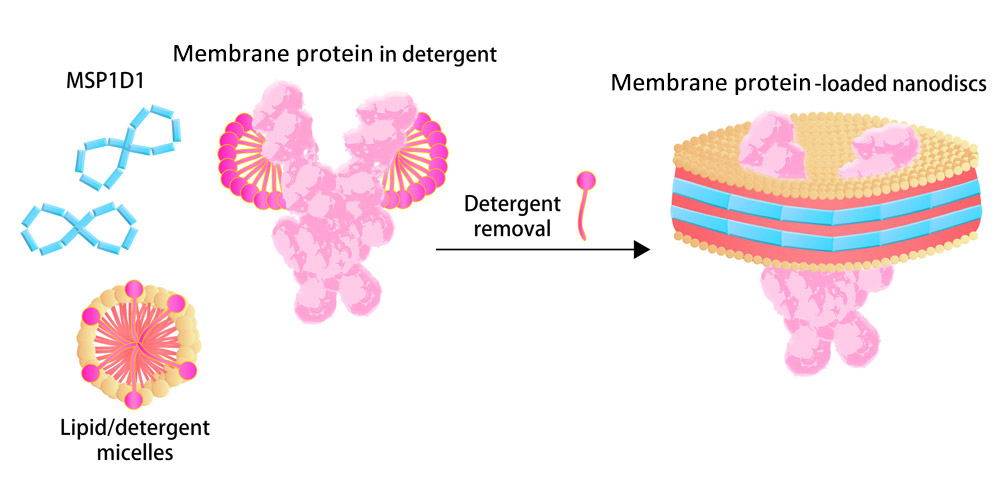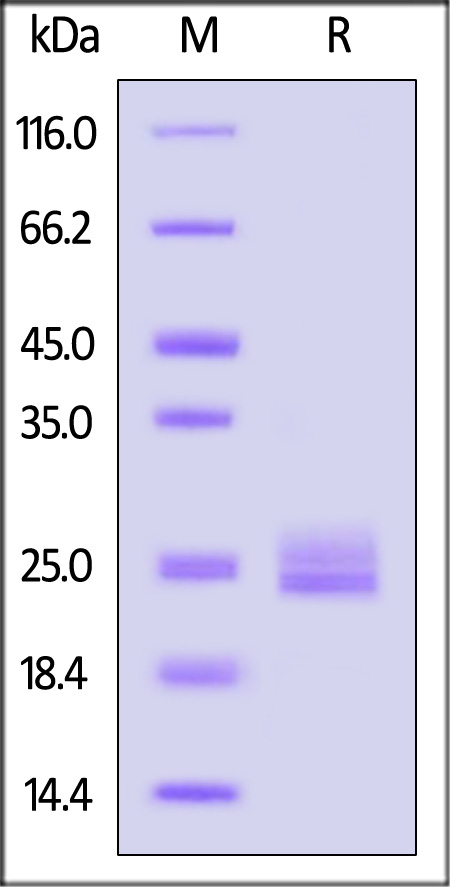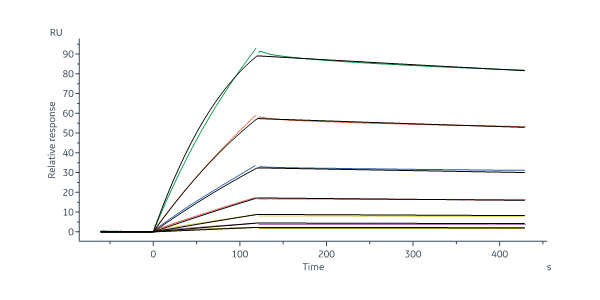分子别名(Synonym)
Claudin-6,CLDN6
表达区间及表达系统(Source)
Human Claudin-6 Protein, His,Twin-Strep Tag (CL6-H5286) is expressed from Baculovirus-Insect cells. It contains AA Ala 2 - Val 220 (Accession # P56747).
Predicted N-terminus: Met
Request for sequence
蛋白结构(Molecular Characterization)

This protein carries a polyhistidine tag at the N-terminus and a twin strep tag at the C-terminus.
The protein has a calculated MW of 28.3 kDa. The protein migrates as 23-28 kDa under reducing (R) condition (SDS-PAGE).
Nanodiscs are a new class of model membranes that are being used to solubilize and study a range of integral membrane proteins and membrane-associated proteins. The Nanodisc bilayer is bounded by a membrane scaffold protein (MSP1D1) coat that confers enhanced stability and a narrow particle size distribution.

The nanodisc assembles from a mixture of full length membrane protein in detergent, phospholipid micelles and membrane scaffold protein(MSP1D1) upon removal of the detergent.
内毒素(Endotoxin)
Less than 1.0 EU per μg by the LAL method.
纯度(Purity)
>90% as determined by SDS-PAGE.
制剂(Formulation)
Supplied as 0.2 μm filtered solution in 20 mM HEPES, 150 mM NaCl, pH7.5 with trehalose as protectant.
Contact us for customized product form or formulation.
运输(Shipping)
This product is supplied and shipped with dry ice, please inquire the shipping cost.
存储(Storage)
Please avoid repeated freeze-thaw cycles.
This product is stable after storage at:
- The product MUST be stored at -70°C or lower upon receipt;
- -70°C for 12 months under sterile conditions.
质量管理控制体系(QMS)
电泳(SDS-PAGE)

Human Claudin-6 Protein, His,Twin-Strep Tag on SDS-PAGE under reducing (R) condition. The gel was stained with Coomassie Blue. The purity of the protein is greater than 90%.
活性(Bioactivity)-ELISA

Immobilized Human Claudin-6 Protein, His,Twin-Strep Tag (Cat. No. CL6-H5286) at 1 μg/mL (100 μL/well) can bind Monoclonal Anti-Human Claudin-6 antibody, Human IgG1 with a linear range of 0.1-2 ng/mL (QC tested).
Protocol
活性(Bioactivity)-SPR

Anti-Claudin-6 Antibody, Human IgG1 captured on Protein A Chip can bind Human Claudin-6 Protein, His,Twin-Strep Tag (Cat. No. CL6-H5286) with an affinity constant of 1.08 nM as determined in a SPR assay (Biacore 8K) (Routinely tested).
Protocol
CAR阳性表达率检测(Evaluation of CAR expression)
FACS Analysis of Anti-Claudin-6 CAR Expression

2e5 of anti-Claudin-6 (AE49-11) CAR-293 cells were stained with 100 μL of 10 μg/mL of Human Claudin-6 Protein, His,Twin-Strep Tag (Cat. No. CL6-H5286) and negative control protein respectively (Fig. A and B), FITC signal was used to evaluate the binding activity (QC tested).
FACS Analysis of Non-specific binding to PBMCs

5e5 of PBMCs were stained with Human Claudin-6 Protein, His,Twin-Strep Tag (Cat. No. CL6-H5286) and anti-CD3 antibody, washed and then analyzed with FACS. PE signal was used to evaluate the expression of CD3+ T cells in PBMCs, and FITC signal was used to evaluate the non-specific binding activity to PBMCs (QC tested).
 +添加评论
+添加评论背景(Background)
Tight junctions represent one mode of cell-to-cell adhesion in epithelial or endothelial cell sheets, forming continuous seals around cells and serving as a physical barrier to prevent solutes and water from passing freely through the paracellular space. These junctions are comprised of sets of continuous networking strands in the outwardly facing cytoplasmic leaflet, with complementary grooves in the inwardly facing extracytoplasmic leaflet. Claudin-6, also knows as CLDN6, is a multipass transmembrane protein in the Claudin family. Claudin-6 is expressed by epithelial cells where it participates in tissue development and the maintenance of tight junction integrity. And it is one of the entry cofactors for hepatitis C virus. The methylation of CLDN6 may be involved in esophageal tumorigenesis. The gene of CLDN6 is adjacent to another family member CLDN9 on chromosome 16.























































 膜杰作
膜杰作 Star Staining
Star Staining
















